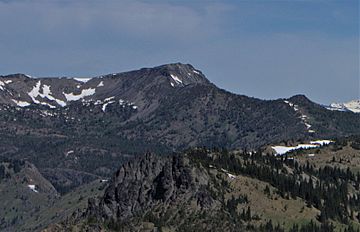Big Jim Mountain facts for kids
Quick facts for kids Big Jim Mountain |
|
|---|---|

Big Jim from southeast
|
|
| Highest point | |
| Elevation | 7,763 ft (2,366 m) |
| Prominence | 483 ft (147 m) |
| Isolation | 1.75 mi (2.82 km) |
| Parent peak | Big Lou (7,780+ ft) |
| Geography | |
| Location | Chelan County Washington state, U.S. |
| Parent range | Chiwaukum Mountains Wenatchee Mountains Cascade Range |
| Topo map | USGS Big Jim Mountain |
| Climbing | |
| Easiest route | class 2 hiking South ridge |
Big Jim Mountain is a tall peak in Washington state. It stands at 7,763 feet (about 2,366 meters) high. You can find it in Chelan County, about 9 miles (14 km) northwest of Leavenworth. This mountain is part of the beautiful Alpine Lakes Wilderness. It is managed by the Okanogan-Wenatchee National Forest.
Big Jim Mountain is the fourth-highest peak in the Chiwaukum Mountains. These mountains are a smaller part of the huge Cascade Range. Its closest higher neighbor is Big Lou, which is about 1.75 miles (2.8 km) away. Even though it's not the tallest mountain, Big Jim rises very steeply. It goes up 2,300 feet (700 meters) in just one mile from Painter Creek Valley. Big Jim Mountain is named after Jim Whittaker. He was the first American to climb Mount Everest, the world's highest peak! Jim Whittaker's twin brother, Lou Whittaker, also has a mountain named after him nearby.
Mountain Weather
Most of the weather for Big Jim Mountain comes from the Pacific Ocean. These weather systems, called fronts, travel east towards the Cascade Range. When they hit the tall Cascade Mountains, the air is forced to rise. As the air goes up, it cools down and drops its moisture. This creates a lot of rain or snow on the mountains. This process is called Orographic lift.
Because of this, the Cascade Mountains get a lot of precipitation. This is especially true during the winter months, when there's a lot of snowfall. In winter, the weather is often cloudy. But in summer, high-pressure systems over the Pacific Ocean bring clear skies. So, the months from June through October usually have the best weather. This is a great time to visit or climb Big Jim Mountain.
How the Mountain Was Made
The Alpine Lakes Wilderness has some very rugged land. You can see jagged peaks, sharp ridges, and deep valleys carved by glaciers. There are also huge granite walls and over 700 mountain lakes. All these different features were created by amazing geological events long ago. These events caused big changes in the land's height and led to different climates.
Millions of years ago, during a time called the Pleistocene period, huge sheets of ice called glaciers moved across the land. They advanced and then melted back many times. As they moved, they scraped and shaped the landscape. They left behind piles of rock and debris. The last time glaciers melted away from the Alpine Lakes area was about 14,000 years ago.
The "U"-shaped valleys you see today were formed by these glaciers. Over time, the land also pushed upwards (this is called uplift). Large cracks in the Earth's crust (called faults) also played a role. These processes, along with the glaciers, created the tall peaks and deep valleys of the Alpine Lakes Wilderness.




